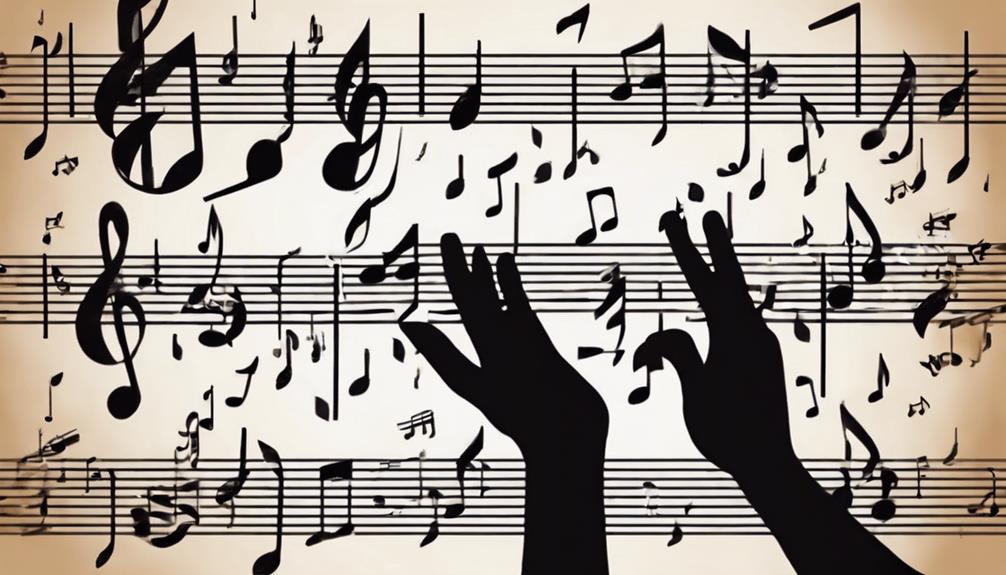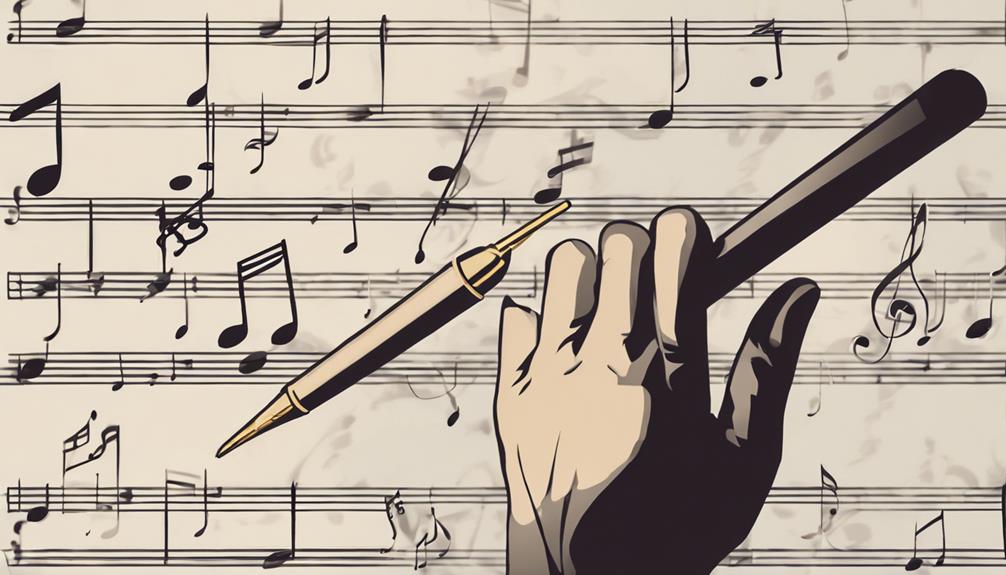No products in the cart.
In the world of songwriting, what glitters isn’t always gold, but a well-crafted melodic hook can certainly turn your tunes into treasures that listeners carry with them. You know the importance of a melody that lingers in the mind long after the song has ended, and achieving this isn’t just a stroke of luck—it’s an art.
Let’s talk about four key strategies to elevate your music.
First, you must become a master of repetition without letting your listeners feel they’re walking in circles.
Simplicity, often overlooked, is your secret weapon to make complex emotions accessible.
Then, it’s about choosing the right notes; a little experimentation with scales can lead to a big payoff.
Finally, don’t underestimate the power of rhythm—it’s the heartbeat of your hook.
Stick around, and you’ll discover how these elements can be the difference between a fleeting tune and an anthem that stands the test of time.
Contents
hide
Key Takeaways
- Utilize repetition techniques with subtle variations in rhythm and pitch to create a memorable hook.
- Embrace melodic simplicity by using a small range of pitches and straightforward rhythms to resonate with listeners.
- Experiment with different scales, such as pentatonic scales for simplicity or unconventional scales for mystery, to add emotional depth to your melodies.
- Incorporate dynamic rhythms, syncopated patterns, off-beat accents, and percussive elements to bring your melody to life and keep listeners engaged.
Master Repetition Techniques
Harness the power of repetition with a twist, because it’s your subtle tweaks in rhythm and pitch that’ll turn a simple loop into a spellbinding melody. As you weave through the tapestry of sound, remember that your quest for the unforgettable hook is a dance with familiarity and the allure of the unexpected.
Explore different chord progressions, let them be the canvas upon which your melodic motifs playfully pirouette. Utilize these motifs effectively; they’re the brushstrokes of your auditory art, the recurring whispers that beckon listeners into the depths of your musical narrative.
To keep the ears perched and the minds engaged, experiment with the heartbeat of your tune—the rhythm. Let it evolve, grow quicker, then slow, as if breathing with the life of the song itself. Lift the pitch gently, a siren’s call, or drop it, a shadow passing beneath the waves of harmony, always mindful of the delicate balance between the comfort of the known and the thrill of innovation.
Introduce new sounds with the precision of a poet choosing their words, each one a strategic step in the journey of your composition. Your melody is a traveler; let each repetition be a footprint on the path to aural ecstasy.
Embrace Melodic Simplicity
As you master the intricate dance of repetition, let’s now strip back the layers to reveal the heart of musical clarity: a melody’s simplest form can often resonate the most profoundly.
Embrace the importance of minimalism in melody creation; it’s the essence of a tune that lingers in the silence, weaving through the complexity of life’s cacophony.
Imagine crafting a hook with only a handful of notes, each one a deliberate step towards an indelible imprint on the listener’s memory. The impact of simplicity on audience engagement is undeniable—stripped-down rhythms and pitches form a universal language that transcends barriers, inviting everyone into the fold.
You’re not just making music; you’re designing experiences through melodic simplicity. Alter pitches and introduce new sounds with care, each variation a brushstroke in your auditory canvas. By focusing on a small range of pitches and straightforward rhythms, your melodies become the heartbeats of your songs, pulsing with the potential to become timeless anthems.
Experiment With Scale Choices

Dive into the colorful world of scales and discover how a simple shift can unveil a new realm of emotional depth in your melodies. Pentatonic scales are your canvas for simplicity and versatility, offering a foundation where your creativity can roam free without the clutter of excessive notes.
Yet, don’t shy away from the emotional tug of war between major and minor modes – they’re the essence of melodic storytelling, capable of lifting spirits or casting shadows with a mere switch in tonality.
Explore unconventional scales to infuse your music with an air of mystery and allure. The exotic scales from distant cultures are like spices – a pinch can transform the familiar into something entirely new and captivating. Create melodic tension by flirting with these unfamiliar tonal landscapes, beckoning listeners into uncharted auditory territories.
Toggle between the brightness of major and the introspective hues of minor modes to craft a dynamic narrative within your songs. And when the soul calls for it, let the blues scale weave its raw, emotive threads through your melodies. The blue notes are like siren calls, their bittersweet dissonance resonating with the human experience, compelling and unforgettable.
Incorporate Dynamic Rhythms
While exploring the emotional palette of scales shapes your melody’s color, infusing dynamic rhythms will breathe life into its movement, keeping listeners hooked on every beat. Imagine your tunes as a dancer—graceful yet unpredictable, moving with purpose and a contagious energy. It’s time to explore syncopated patterns, those delightful surprises that skip through the fabric of expectations, crafting an irresistible ebb and flow.
Utilize off-beat accents to punctuate your musical sentences, giving your audience a reason to nod their heads or tap their feet. It’s not just about the notes you play; it’s where you place them in time. A well-placed off-beat accent can turn a simple melody into an anthem that pulses through the hearts of your listeners.
Rhythmic Variety | Time Signatures | Effects
— | — | —
Syncopation | 3/4 Waltz | Groovy Sway
Off-beat Accents | 7/8 Complexity | Unexpected Twists
Danceable Beats | 4/4 Classic | Infectious Groove
Percussive Elements | 5/4 Unusual | Rhythmic Intrigue
Balanced Experimentation | 6/8 Flowing | Easy Engagement
Dare to weave these dynamic rhythms into your melodic tapestry. Your music will not only sound innovative but feel alive, moving with a heartbeat of its own, captivating those who dare to listen.
Frequently Asked Questions
How Do You Make a Catchy Hook?
You’ll create a catchy hook by blending unique chord progressions with innovative vocal techniques, ensuring your melody dances and resonates. Keep it simple, yet striking, to capture and linger in your audience’s imagination.
How Do You Make a Melodic Hook?
To create a melodic hook, experiment with unique chord progressions and instrumentation choices that resonate with your creative spirit, ensuring it’s an innovative echo that’ll linger in listeners’ minds.
How Do You Make a Melody Catchy?
To craft a catchy melody, you’ll want to blend melodic repetition with note simplicity, creating a tune that dances memorably in the listener’s mind, sparking creativity and a hunger for sonic innovation.
How Do You Make Catchy Rhythms?
To create catchy rhythms, you’ll want to play with beat variations and master rhythmic syncopation. Push boundaries, mix tempos, and let your beats dance and sway to captivate and energize your listeners.
Conclusion
Now, you’ve got the rhythm in your heart and the melody in your mind. Spin those simple tunes, repeat the beats that catch, and play with scales that surprise.
Let the rhythm dance, bold and dynamic, creating the pulse that listeners can’t resist. You’re the maestro of hooks, crafting earworms that’ll linger long after the last note fades.
Go on, make your mark with melodies that sing, soar, and stick. It’s your song—make it unforgettable.




